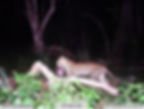
WILPATTU NATIONAL PARK
Update, 2021:
Kittle, A.M., Watson, A.C., & Samaranayake, P.K.L. 2021. Edge effects and distribution of prey forage resources influence how an apex predator utilizes Sri Lanka’s largest protected area. Journal of Zoology 314: 31-42.
Wilpattu was regarded as one of the premier locations in the country to view leopards and before the civil conflict that erupted on the island in 1983, this was considered the absolute top location. The Smithsonian Institution conducted biodiversity surveys of Wilpattu, including some preliminary work on leopard range size and activity times in the late 1960s. As the largest protected area in the country, Wilpattu might be a very important reserve for threatened wildlife so a population survey was highly warranted.
Exceptionally heavy rains in the dry zone in 2014 and 2015 resulted in very high water levels within Wilpattu far into the dry season (Fig.1). With park access critical, WWCT commenced remote camera trapping in mid-July in order to avoid the worst of the flooding and ensure that the project was finished by the onset of the north-east monsoon in mid-October.
A total of 36 remote camera stations were set up across the central portion of Wilpattu covering an area of ~ 500 km². This design allowed the project to optimize the trade-off between photo recaptures and area coverage. 3 prey transects (20 – 23 km) that traversed the heart of the study area were conducted monthly and were continued into 2017.
Over the course of the 836 trap days/nights, a total of 49 individual leopards were photo-captured (Fig. 2). Using spatially explicit capture-recapture analysis a healthy population density within the study area was revealed with a density slightly lower than in Yala National Park, Block I (in press, Tropical Ecology) and slightly higher than in Horton Plains National Park (submitted).
Analysis of prey distribution and abundance is ongoing with several thousand remote camera images initially being processed by students and volunteers before being analysed by WWCT’s PI. The capture of several rusty-spotted cats indicates a healthy population inhabits the park. A high presence of bears (with cubs) was also detected throughout the study area indicating that this central core area of Wilpattu is still home to a healthy bear population which reflects on the stable ecosystem within the park.
This prey data, together with other input variables, will be utilized in the creation of resource selection function models with the aim to increase understanding of ecological and anthropogenic factors that influence leopard spatial dynamics within Wilpattu.



The WWCT Team
December 2016
For information please see the recent publication, the WWCT 2015 Annual Report, and Update Report of 2016.